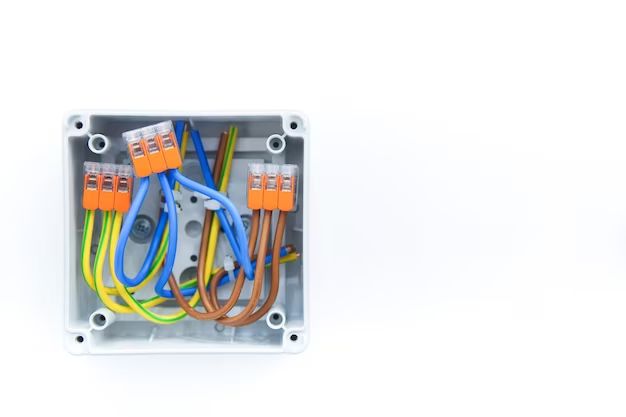Determining the number of 12 gauge wires allowed in an electrical junction box is important for creating safe and code-compliant electrical systems. The National Electrical Code (NEC) provides guidelines on the maximum number of conductors allowed based on the size of the junction box. Knowing these requirements helps electricians properly size junction boxes and avoid overfilling that can lead to overheating and fire hazards.
Page Contents
Key Factors
There are a few key factors that determine the number of 12 gauge wires allowed in a junction box:
Junction Box Volume
The volume of the junction box determines the total amount of wire that can be placed inside. Junction boxes are commonly available in cubic inch ratings such as 18 cu in, 24 cu in, 28 cu in and so on. The greater the cubic inch capacity, the more wires the box can accommodate.
Wire Gauge
12 gauge wire is a common size used for 15, 20 and 30 amp branch circuits. The diameter of the copper wire and thickness of the insulation determine its cubic inch per foot volume, which affects junction box fill calculations.
Number of Conductors
The number of wires entering and leaving the junction box impacts the total volume of wire to be installed. More wires take up more space.
Splices
Any splices or wire connectors inside the box also take up space. More splices mean less room for conductors.
Box Type
Different box types like standard, handy, conduit bodies, etc. allow for different wire fill capacity. Their shape and construction can increase or reduce total fill space.
Fill Calculations
The NEC provides guidelines on how much space each current-carrying conductor can occupy in a junction box based on the box’s total cubic inch volume. This determines the maximum number of wires allowed. Here are the key rules:
Conductor Fill for Standard Junction Boxes
– Each current-carrying conductor can occupy no more than 2 cubic inches in a standard junction box. A 12 gauge copper wire takes up approximately 0.023 cubic inches per linear foot.
– For example, in a 24 cu in junction box, a maximum of 24 / 2 = 12, 12 gauge conductors would be allowed.
Adjustments for Splices, Clamps etc.
– Each wire connector or splice counts as 2.5 cubic inches. This space must be subtracted from the total box volume.
– Clamps, screws etc also occupy space which must be adjusted in calculations.
– For example, a 24 cu in box with two splices and a clamp would have:
24 cu in (total volume)
– 5 cu in (2 splices x 2.5 cu in)
– 1 cu in (1 clamp)
= 18 cu in remaining
Conductor Fill for Other Box Types
– Handy boxes have a maximum of 16 cubic inches of conductor fill space regardless of their size.
– Round junction boxes usually allow a maximum of 25 current carrying conductors.
– Wire fill for other specific box types are given in NEC 314.16.
Fill Calculation Examples
Let’s look at some examples to understand the wire fill calculations:
Example 1
A standard 24 cu in junction box contains five 12 gauge wires entering and leaving the box plus three splices inside.
– 5 x 12 gauge wires x 0.023 cu in per ft = 0.115 cu in
– 3 splices x 2.5 cu in per splice = 7.5 cu in
Total fill = 0.115 + 7.5 = 7.615 cu in
This is within the limit of 24 cu in total volume.
Example 2
A handy box is marked as 20 cu in on its label. It contains three 12 gauge cables with a total of 9 conductors.
– Per NEC, maximum fill for a handy box is 16 cu in regardless of marked volume.
– 9 conductors x 0.023 cu in per ft = 0.207 cu in
Total fill = 0.207 cu in, which is less than 16 cu in limit. So this box fill is code compliant.
Example 3
A standard 16 cu in box contains three 12 gauge wires, two 14 gauge wires, two splices and one dome cover screw.
– 3 x 12 gauge wires = 3 x 0.023 = 0.069 cu in
– 2 x 14 gauge wires = 2 x 0.021 = 0.042 cu in
– 2 splices = 2 x 2.5 = 5 cu in
– 1 screw = 1 cu in
Total fill = 0.069 + 0.042 + 5 + 1 = 6.111 cu in
This is within the 16 cu in allowable limit.
Junction Box Volume Tables
Here are some reference tables showing the maximum number of wires allowed for common junction box sizes:
| Junction Box Volume | 12 AWG Wires Allowed |
|---|---|
| 18 cu in | 9 |
| 24 cu in | 12 |
| 28 cu in | 14 |
| 32 cu in | 16 |
Note that actual wire counts may need to be derated based on the number of splices, clamps and other adjustments per NEC guidelines. The above table gives the maximum wires before derating.
Conclusion
Determining junction box fill capacity requires calculating the total cubic inch volume of all conductors based on wire gauge and number of wires, and adjusting for splices, clamps and other fittings. 12 gauge wires are permitted 2 cubic inches per conductor in standard boxes as per NEC 314.16. Following these code requirements ensures junction boxes are properly filled without overcrowding wires. Overfilled boxes can lead to overheating failures and electrical fires.
